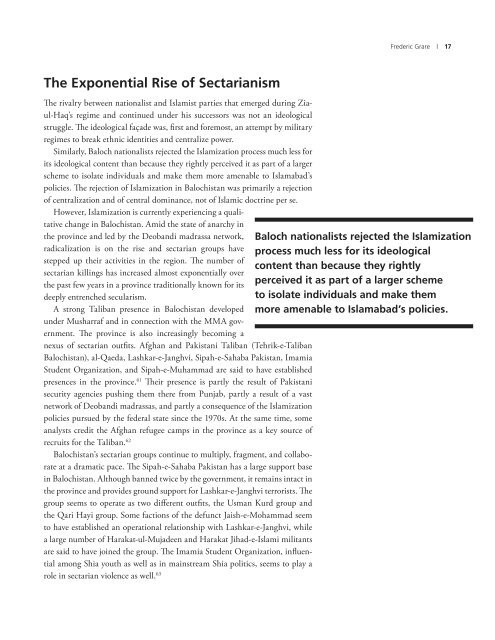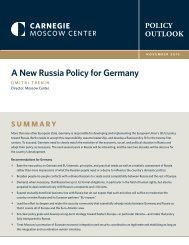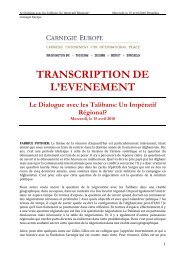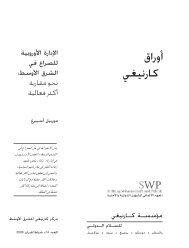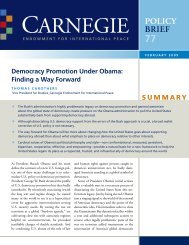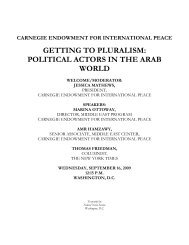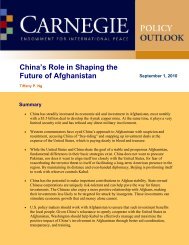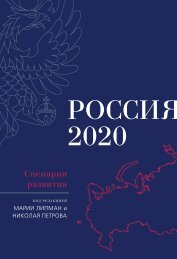BALOCHISTAN - Carnegie Endowment for International Peace
BALOCHISTAN - Carnegie Endowment for International Peace
BALOCHISTAN - Carnegie Endowment for International Peace
Create successful ePaper yourself
Turn your PDF publications into a flip-book with our unique Google optimized e-Paper software.
The Exponential Rise of Sectarianism<br />
The rivalry between nationalist and Islamist parties that emerged during Ziaul-Haq’s<br />
regime and continued under his successors was not an ideological<br />
struggle. The ideological façade was, first and <strong>for</strong>emost, an attempt by military<br />
regimes to break ethnic identities and centralize power.<br />
Similarly, Baloch nationalists rejected the Islamization process much less <strong>for</strong><br />
its ideological content than because they rightly perceived it as part of a larger<br />
scheme to isolate individuals and make them more amenable to Islamabad’s<br />
policies. The rejection of Islamization in Balochistan was primarily a rejection<br />
of centralization and of central dominance, not of Islamic doctrine per se.<br />
However, Islamization is currently experiencing a qualitative<br />
change in Balochistan. Amid the state of anarchy in<br />
the province and led by the Deobandi madrassa network,<br />
radicalization is on the rise and sectarian groups have<br />
stepped up their activities in the region. The number of<br />
sectarian killings has increased almost exponentially over<br />
the past few years in a province traditionally known <strong>for</strong> its<br />
deeply entrenched secularism.<br />
A strong Taliban presence in Balochistan developed<br />
under Musharraf and in connection with the MMA government.<br />
The province is also increasingly becoming a<br />
nexus of sectarian outfits. Afghan and Pakistani Taliban (Tehrik-e-Taliban<br />
Balochistan), al-Qaeda, Lashkar-e-Janghvi, Sipah-e-Sahaba Pakistan, Imamia<br />
Student Organization, and Sipah-e-Muhammad are said to have established<br />
presences in the province. 61 Their presence is partly the result of Pakistani<br />
security agencies pushing them there from Punjab, partly a result of a vast<br />
network of Deobandi madrassas, and partly a consequence of the Islamization<br />
policies pursued by the federal state since the 1970s. At the same time, some<br />
analysts credit the Afghan refugee camps in the province as a key source of<br />
recruits <strong>for</strong> the Taliban. 62<br />
Balochistan’s sectarian groups continue to multiply, fragment, and collaborate<br />
at a dramatic pace. The Sipah-e-Sahaba Pakistan has a large support base<br />
in Balochistan. Although banned twice by the government, it remains intact in<br />
the province and provides ground support <strong>for</strong> Lashkar-e-Janghvi terrorists. The<br />
group seems to operate as two different outfits, the Usman Kurd group and<br />
the Qari Hayi group. Some factions of the defunct Jaish-e-Mohammad seem<br />
to have established an operational relationship with Lashkar-e-Janghvi, while<br />
a large number of Harakat-ul-Mujadeen and Harakat Jihad-e-Islami militants<br />
are said to have joined the group. The Imamia Student Organization, influential<br />
among Shia youth as well as in mainstream Shia politics, seems to play a<br />
role in sectarian violence as well. 63<br />
Frederic Grare | 17<br />
Baloch nationalists rejected the Islamization<br />
process much less <strong>for</strong> its ideological<br />
content than because they rightly<br />
perceived it as part of a larger scheme<br />
to isolate individuals and make them<br />
more amenable to Islamabad’s policies.


